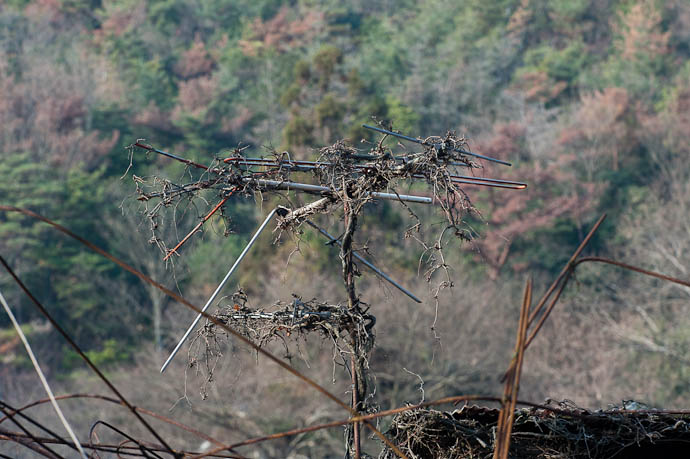
Nikon D700 + Nikkor 70-200mm f/2.8 @ 175 mm — 1/500 sec, f/9, ISO 2200 — map & image data — nearby photos
TV Antenna Worthy of a Haunted House
As I've mentioned lately, I've taken to heading up to Shogunzuka to try to catch the sunset in hopes of getting lucky and being able to photograph one that's spectacular. During the five-minute drive home one day recently, I noticed this view...
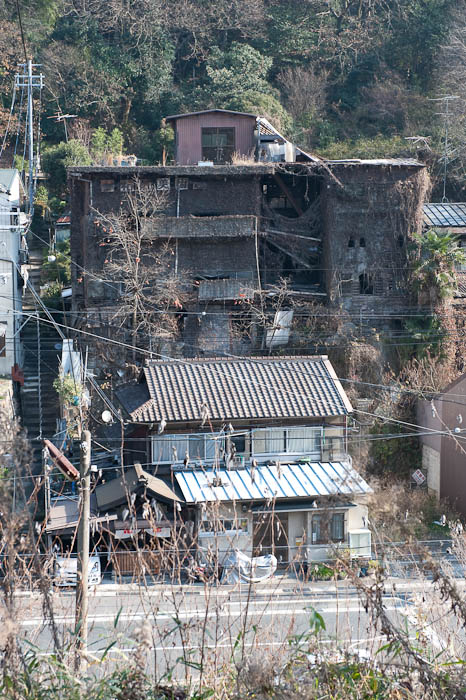
Nikon D700 + Nikkor 24-70mm f/2.8 @ 70 mm — 1/160 sec, f/7.1, ISO 250 — map & image data — nearby photos
Haunted House?
Kyoto, Japan
That big building in the background looks totally decrepit, and despite having driving by it a bazillion times, I'd not noticed it until now. I find these kinds of places somewhat fascinating, and along the same lines, posted Abandoned House Returning To Nature last month, and about the razing of an Old House of Bamboo and Mud last year.
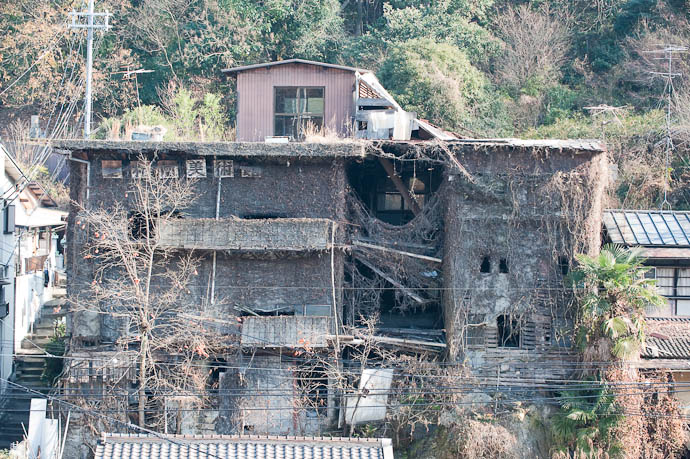
Nikon D700 + Nikkor 70-200mm f/2.8 @ 102 mm — 1/500 sec, f/7.1, ISO 2000 — map & image data — nearby photos
Front-Facing Side
I had no idea what it was, but finally the other day I headed over, and it turns out to have been much more interesting than I had first imagined.
In the picture above, note the set of stairs running to the left of the building (the main approach is via those stairs), and also the tree in front of the left side of the building (because it's not in front of the building, but in the building, sticking out the front. We'll see more below.)
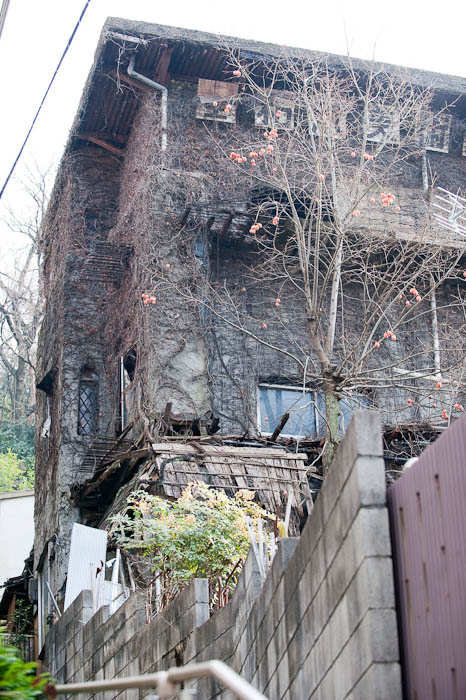
Nikon D700 + Nikkor 70-200mm f/2.8 @ 70 mm — 1/500 sec, f/4, ISO 560 — map & image data — nearby photos
Initial Approach
The nearest corner in the shot above is where the main entrance is, facing the stairs, so continuing up the stairs to the corner and turning right, you see this inviting portal....
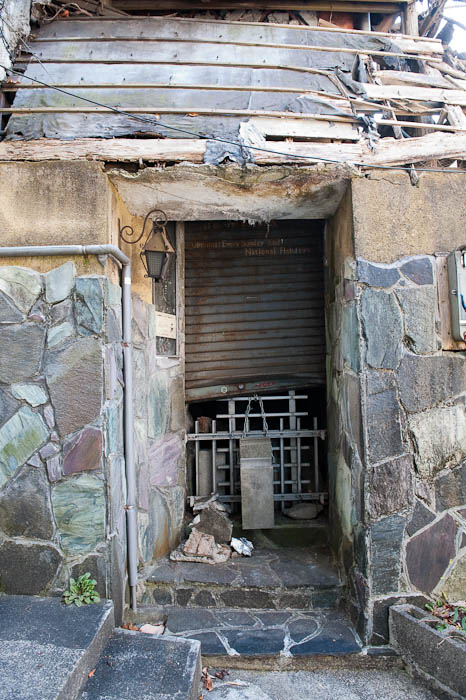
Nikon D700 + Nikkor 24-70mm f/2.8 @ 24 mm — 1/160 sec, f/5, ISO 4000 — map & image data — nearby photos
Welcome!
I had a similar shot on my previous post, A Few Kyoto Entrances.
Not having had any idea what the building actually was, I guess I had built up a subconscious idea that it was a dorm or low-rent apartment of some sort, likely because of my experiences detailed in Forsaken: Kyoto University's Kumano Dorm.
It is clearly abandoned now, but I was somewhat surprised to see that it had been a business of some sort. The writing on the shutter above has a phone number, and says in English “Opening: Every Sunday and National Holidays”
In taking the shot above, I sat on the steps to the house across the way. An old lady lived there, and we chatted a while about the place. Her accent was one so extremely thick that I couldn't understand much, but did learn this: the outside was never particularly nice, but it had been quite nice inside. There are five floors. A man had lived there, and when he died some years ago, it just went to pot due to neglect and vandals. An attempt was made to sell it, but no one will buy it because the situation is just too difficult to deal with. Kids call it a haunted house (お化け屋敷 · obakeyashiki).
The situation she referred to is that it's on the side of a very steep hill, and is surrounded by other properties, so heavy equipment has no easy access. Even if combined with one of the properties between it and the road such that it would have frontage and access, the cost of taking it down likely far exceeds the cost of the land. It's just a no-win situation.
The front of the building has a big sign in the upper corner, reading “全和凰美術館” (Zen Kowako Museum), and searching around on the Internet after I got home I found an older photo of the metal shutter, fully closed indicating the name in English as Hua Huan Museum. I'm guessing that Kowako Zen was the professional name used by the artist whose real name was Hua Huan. From what I have been able to figure out while searching, he was born in Korea in 1909, came to Japan when he was 30, eventually apprenticed under Kunitaro Suda (1891-1961), a Kyoto painter apparently noteworthy enough to have a Wikipedia entry.
He was apparently a successful artist. In 1982 there was an exhibition “50 years of work by Kowako Zen” hosted in five cities in Japan and Korea, and perhaps emboldened by that, in the same year he founded the museum that is the subject of the present blog post.
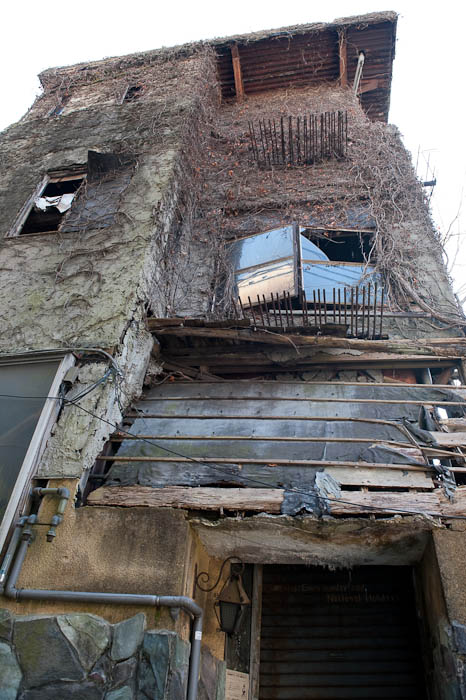
Nikon D700 + Nikkor 24-70mm f/2.8 @ 24 mm — 1/160 sec, f/5, ISO 500 — map & image data — nearby photos
Looking Up
above the entrance
He passed away in 1996. You can still find his work on Yahoo! Auctions as I write this.
I'm guessing that he was really eccentric, because what I found so amazing about this building is not how dilapidated time and vandals and neglect have made it, but how it was build dilapidated to begin with. Pretty much every aspect of what you can see of its construction reveals the utmost in sloppy, dangerous, haphazard, jerry-built jury-rigged “workmanship” that makes the average slumlord look like Bob Vila or Norm Abram.
Those familiar with construction techniques will find hours of amusement and horror in inspecting the large versions of the images that follow.
Many of the outside surfaces were stuccoed as if the stucco was paint, put on thinly enough to just cover (sort of, barely) whatever was underneath...
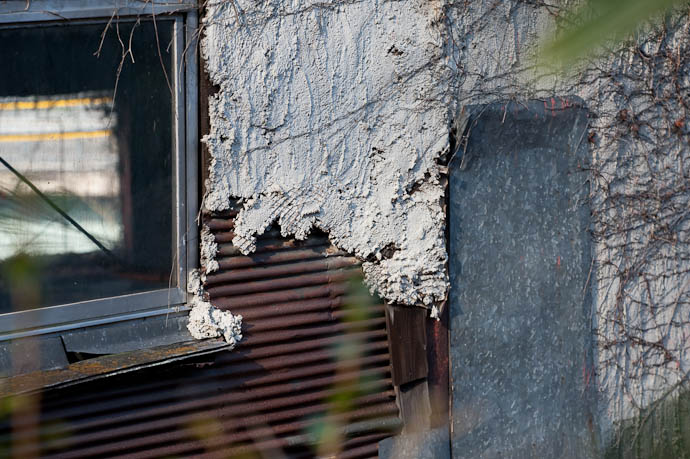
Nikon D700 + Nikkor 70-200mm f/2.8 @ 160 mm — 1/500 sec, f/5.6, ISO 560 — full exif & map — nearby photos
Stucco Like Paint
Often the stucco didn't even cover the light mesh he used (the mesh looks more appropriate for straining carrots than supporting cement), and even the vines that (later?) grew and died were thicker than the stucco...
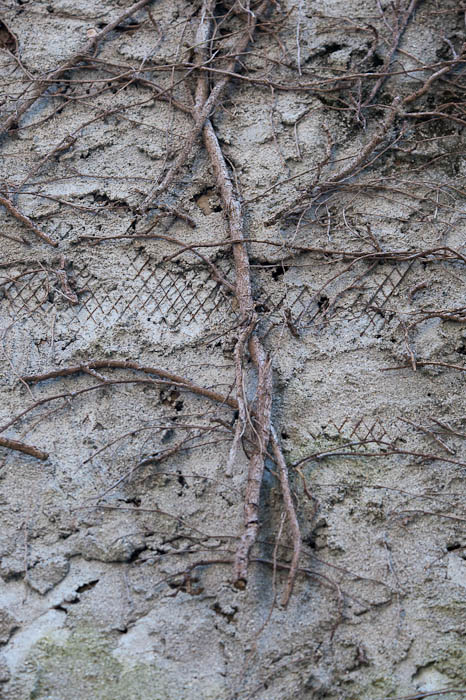
Nikon D700 + Nikkor 70-200mm f/2.8 @ 120 mm — 1/500 sec, f/5.6, ISO 3200 — map & image data — nearby photos
Exterior Wall
I think that there was an original building that was smaller, and that the guy then built it up over time. One of the exposed boards over the entrance shows the old kind of rough-hewn semi-flat teardrop-head “cut nails” one might find in The States in construction that dated to the 1700s and 1800s....
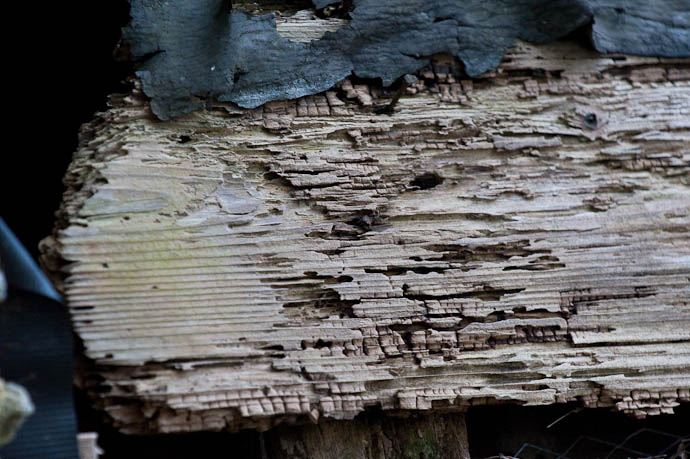
Nikon D700 + Nikkor 70-200mm f/2.8 @ 220 mm — 1/500 sec, f/6.3, ISO 3200 — map & image data — nearby photos
Seen Better Days
Directly beside the entrance was the former electrical hookup, for which no expense was spared in making it look aesthetic and natural. Smartly hidden in plain sight, the ugly conduit looks just like, er, grout, and the box itself like a fine slab of granite....
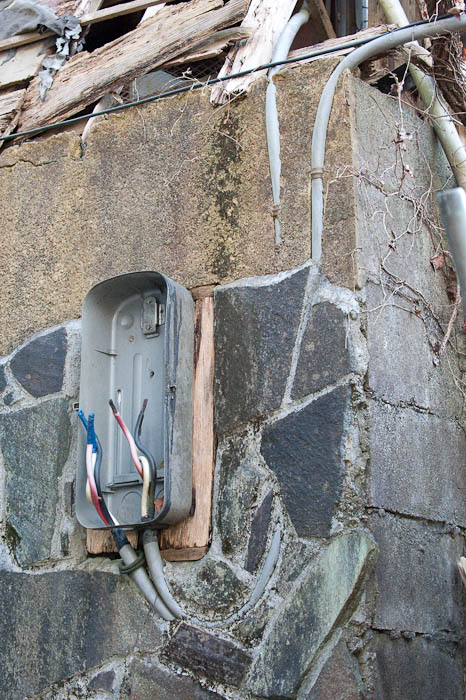
Nikon D700 + Nikkor 70-200mm f/2.8 @ 70 mm — 1/400 sec, f/7.1, ISO 6400 — map & image data — nearby photos
Electrical Hookup
I know you can't really see it because it's disguised so well
The only thing that could be done to add to the tasteful design would be to place a sign on it saying “DO NOT LOOK AT UGLY ELECTRICAL HOOKUP.”
Above that was the remains of an awning that just defies explanation...
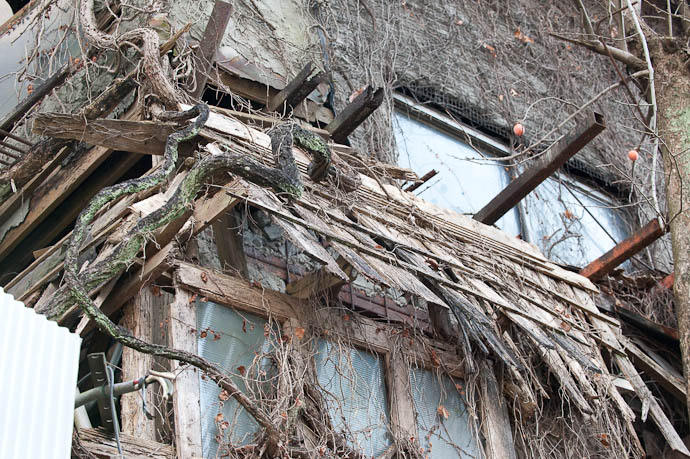
Nikon D700 + Nikkor 70-200mm f/2.8 @ 75 mm — 1/500 sec, f/7.1, ISO 2800 — map & image data — nearby photos
Awning
Originally. Sort of. I think. Not Sure.
On the far right of the photo above, you can see a bit of a tree trunk. That's the tree I asked you to note in one of the pictures we saw before, of the front of the building facing the road. The next shot shows it more clearly, that a tree has grown up from.... somewhere... and has destroyed part of the exterior wall...
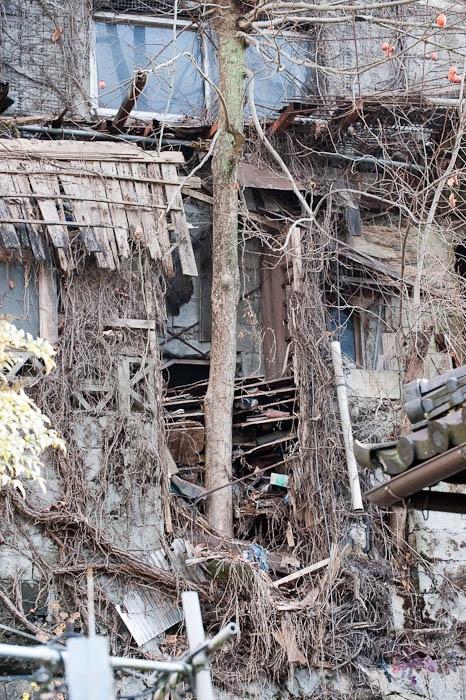
Nikon D700 + Nikkor 70-200mm f/2.8 @ 105 mm — 1/500 sec, f/7.1, ISO 3200 — map & image data — nearby photos
Don't Mind Me
I'm just passing through
The wall that was destroyed was apparently the back of a shoe closet. It's adjacent to the entrance area, so the shoe closet makes sense. In the next detail shot, you can see shoes, slippers, a milk carton, and a bunch of Asahi Lager Beer bottles....
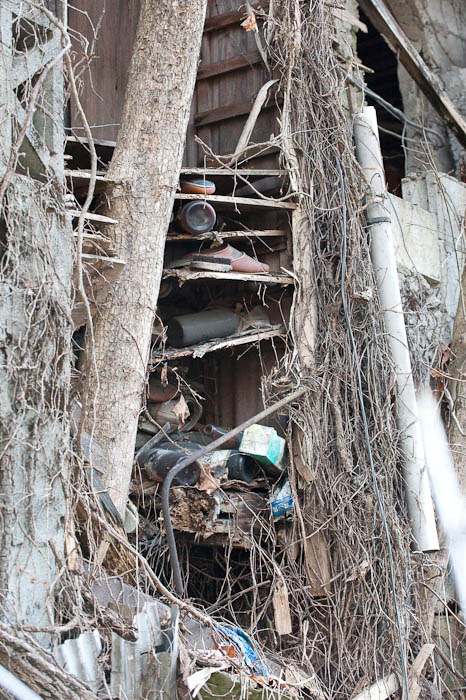
Nikon D700 + Nikkor 70-200mm f/2.8 @ 102 mm — 1/500 sec, f/7.1, ISO 5000 — map & image data — nearby photos
“Easy, Convenient Access”
Taking a wider view of the front, you can see..... well, I'm not sure...
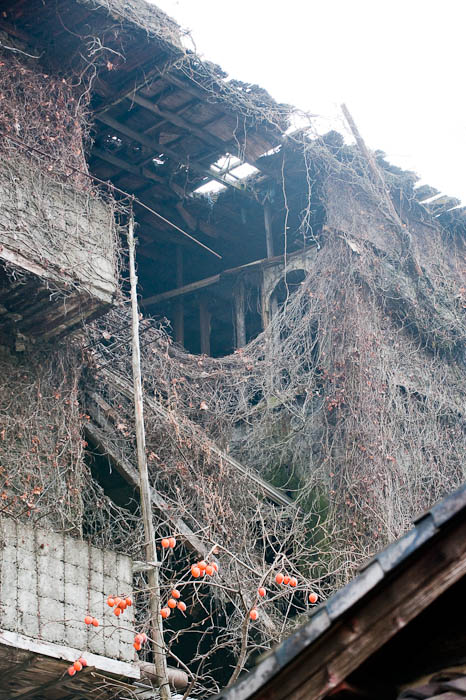
Nikon D700 + Nikkor 70-200mm f/2.8 @ 110 mm — 1/500 sec, f/7.1, ISO 2000 — map & image data — nearby photos
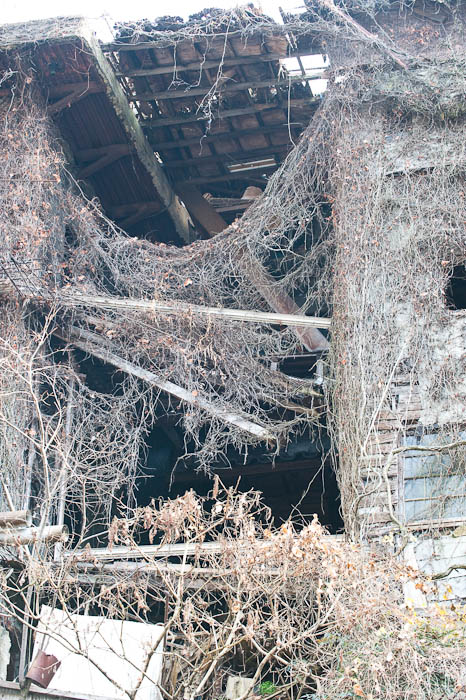
Nikon D700 + Nikkor 70-200mm f/2.8 @ 95 mm — 1/500 sec, f/5.6, ISO 2000 — map & image data — nearby photos
It's hard to figure this out, but it's clear that the vines were more sturdy than the wall. I'm guessing that the original building was tall but not deep, and that the guy tried to connect it to another building next to it, throwing up some timber to make a roof that's mostly still there, but whose walls have long deteriorated.
The balcony you can see in the first of the pair above look decidedly “aftermarket” to me, with cinderblock walls and wooden floors. Only Lord knows how this can possibly remain standing, but I suspect that the overwhelming vine growth has imparted more strength than the original construction did.
Swinging back around to the entrance side, looking up, I see raw rebar sticking out below the windows, so perhaps balconies were on the agenda here, too...
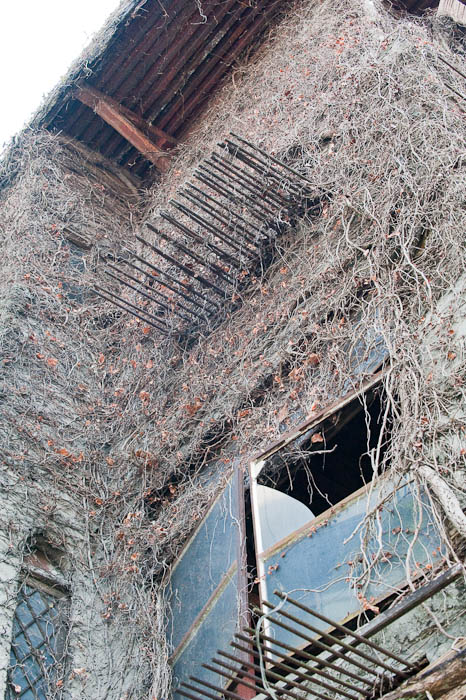
Nikon D700 + Nikkor 70-200mm f/2.8 @ 70 mm — 1/500 sec, f/7.1, ISO 6400 — map & image data — nearby photos
deathtrap
“Under Construction”
As you climbed the stairs up the hillside, the view of the building changed, with more vine and less detail, but still a lot of incomprehensible construction to bemuse and amuse...
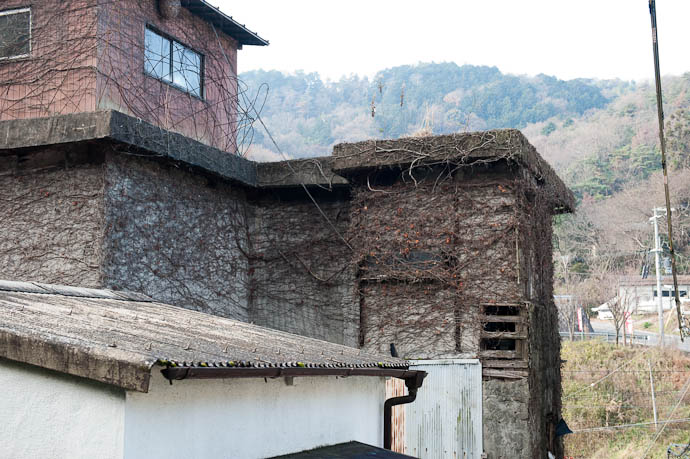
Nikon D700 + Nikkor 24-70mm f/2.8 @ 48 mm — 1/500 sec, f/5, ISO 2800 — map & image data — nearby photos
The big ball hanging under the eaves in the upper-left corner of the shot above is a big wasp nest, I think...
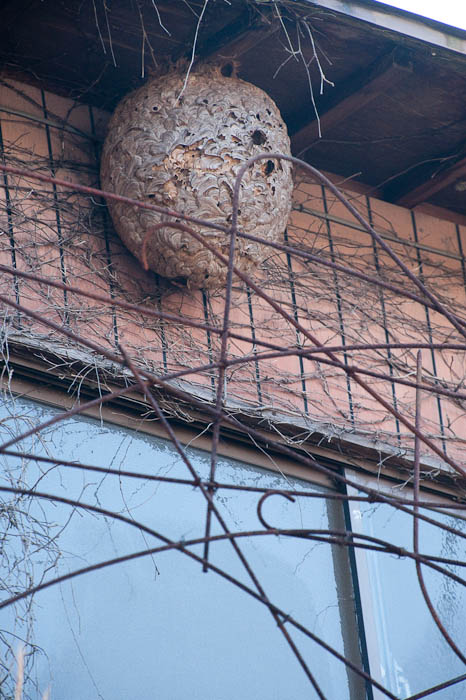
Nikon D700 + Nikkor 70-200mm f/2.8 @ 340 mm — 1/500 sec, f/5.6, ISO 2500 — map & image data — nearby photos
New(?) Tenants
From the hillside behind, you're looking directly into what the old lady said was the fifth floor...
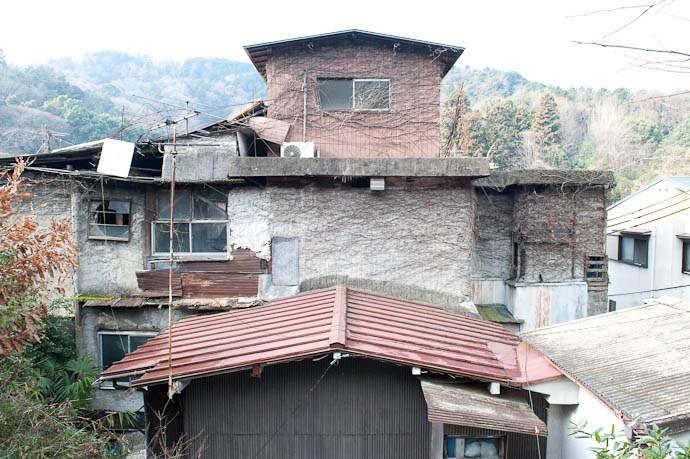
Nikon D700 + Nikkor 24-70mm f/2.8 @ 24 mm — 1/500 sec, f/9, ISO 4000 — map & image data — nearby photos
Rear of the Museum
Among the many things to note in this picture is the circular window toward the left. A number of other buildings in this area have circular windows, which otherwise seem very rare. My gut tells me that this is an important architectural clue that might be used to date the structure (if you didn't want to go to the trouble of asking the city to check the tax records).
Moving further to the left, now at the opposite corner from (and four or five stories above) the entrance, we're at a scene that at first glance looks like simple deterioration, but like so many, reveals upon closer inspection construction that is horrid on every level...
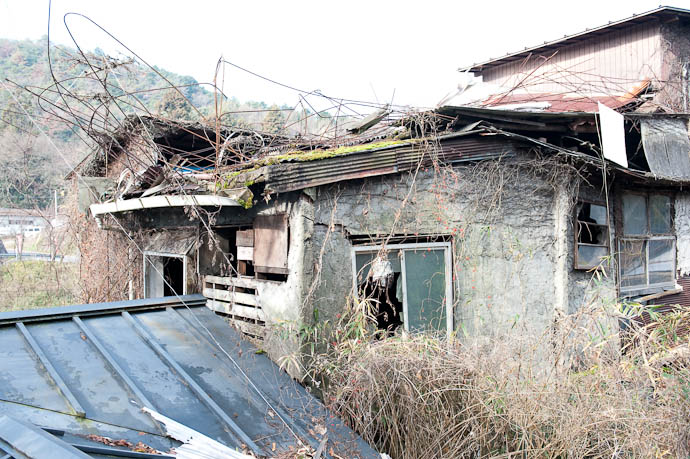
Nikon D700 + Nikkor 24-70mm f/2.8 @ 32 mm — 1/500 sec, f/5, ISO 900 — map & image data — nearby photos
Rear Corner
You can see in the upper-left the TV antenna that was featured at the top of this post. There's also a lot of thick looped wire all tangled up all over the place, and I'm not sure what it is, but my first impression is that it might have been something that was intended to be a decorative fence along a garden path, but which the guy used in lieu of a safety rail when he decided to make the roof a living space.
I'd like to end this post on a less ramshackled note, so let's return to the main entrance, where the museum name is still painted on the window, and a pleasant porch light waits to welcome you home...
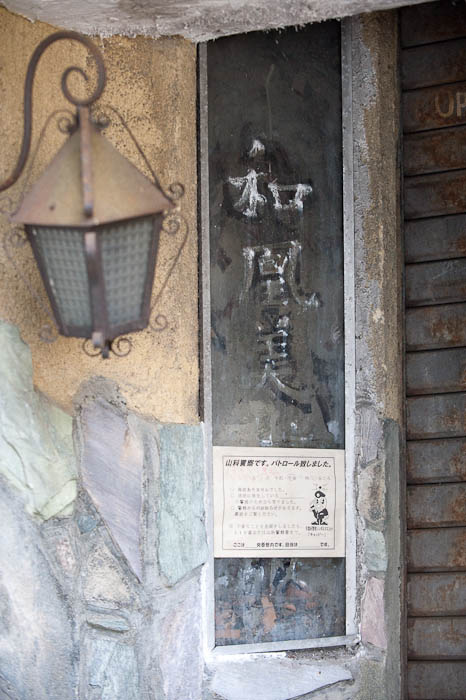
Nikon D700 + Nikkor 70-200mm f/2.8 @ 86 mm — 1/500 sec, f/3.5, ISO 3200 — map & image data — nearby photos
The paper stuck to the window notes that a prefectural policeman visited at about 4:30pm on October 11th of some unknown year, with a handwritten note saying “No Entry”.
Wow. Where you able to get safely close to any windows? Since there were still shoes in the closet, I wonder if there are any furnishings in that house?
I couldn’t see inside except for at the top floor, from a distance, and things seemed pretty stripped away down to the studs. Maybe the walls up there never had drywall or the like… dunno. —Jeffy
Fascinating series.
It puts me in mind of a very different, but similarly abandoned, house I came across in the Scottish Highlands – I won’t name it, since the family still lives on elsewhere! It had been the family home for a couple of centuries, and was described at length in a book, yet had been abandoned by its owner after World War II (during which, I was told, it had been occupied by Canadian troops). When I visited, about 1971, it contained much rather good-looking furniture, a Steinway grand piano, many books… yet the windows were out, the floors rotten and collapsed. So sad to behold. At least that place lives on in a sense, in the book I mentioned.
Creepy, but intriguing.
Well, writing that prompted me to Google it, and I was delighted to find that the new Laird took it back into his care in 1978, so all can be revealed: http://www.rothiemurchus.net/Pages/About%20Us/History/Doune.html. Totally irrelevant to your story, but having started, I had to finish!
Fascinating. I guess someone left a persimmon somewhere and it sprouted. Renewal amidst decay.
Fascinating post. I’m amazed that at last I’ve seen a place where I can see absolutely no “potential”. None. Maybe there were few building codes in place when this was built…er, cobbled together, though with all the earthquakes, it must be sturdier than it looks. Or the vines are holding it together well.Could this be considered “going green”?
Peter, thanks for the follow-up on your notes. I wonder..can you explain why so few castles and grand homes in England and Scotland seem to have absolutely no landscaping, or vegetation of any kind, around them.? At least the many photos I’ve seen show nothing close by the structure/ Perhaps there are plantings further beyond the buildings. Would the lack pf plantings be for protection from sneak attacks or just the prevailing style? I’ve always wondered.
Very interesting. I suspect/fear that our Mom will see a “fixer upper” here rather than a “tear downer”. I can hear her shouting something about “PO-tential!”
Hah, you were writing your comments at the same time; her’s came in the minute before yours. 🙂 —Jeffy
Sumimasen, kokoni doorimasenka…
Hi, I came from AnimeSuki. I am here to recommend you a good website about Kyoto: http://www.deepkyoto.com/
Make sure to go to Cafe Proverbs especially, it makes me hungry just thinking about it.
Grandma Friedl: I was beginning to feel embarrassed at going off at a tangent… but your question is interesting, and takes me even further off – sorry, Jeffrey!
I’m not so sure that I’d agree that few grand homes in the British Isles have associated gardens. A look at the websites of the National Trust or the National Trust for Scotland would show many fine houses with equally fine gardens – both kitchen and ornamental gardens.
Castles, though are a different matter – usually. I suppose one has to distinguish between ‘real’ castles, built for defence (or subjugation of the natives, as in Wales!), and what might be called ‘show castles’ which are just grand homes given a castley look for appearance’s sake – like Sissinghurst Castle in Kent.
I’m sure that ornamental gardens were the last thing on the builders’ minds with the first type, the real castles. As you suggest, any plantation could well conceal an enemy. A few such castles do now have gardens, but these are much more recent developments, as at Leeds Castle in Kent, Cawdor Castle in Scotland, and no doubt some others.
Happy New Year to all the Friedls!
Thanks, Jeff, for allowing Peter to post here. I believe a lot of folks will find his various comments as interesting as I. And thanks to Peter to your response. I always sort of wondered about that. And thanks to Paul for clearing up the persimmon tree. I couldn’t be sure what it was, nor did I realize persimmons grew in Japan.
That’s really funny that grandma Friedl’s post just arrived a minute before the comment of one of her other sons and both mentioned the term “potential”. 🙂
We all grew up hearing that word. 🙂 —Jeffrey